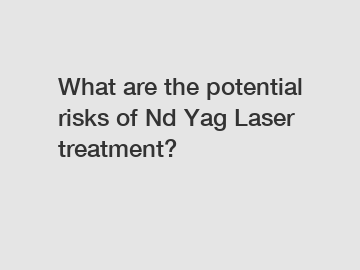What are the potential risks of Nd Yag Laser treatment?
Potential Risks of Nd Yag Laser Treatment.
Nd Yag laser treatment, also known as neodymium-doped yttrium aluminium garnet laser treatment, is a popular non-invasive procedure used for various cosmetic and medical purposes. It is commonly used for tattoo removal, hair removal, skin rejuvenation, and treating vascular lesions. While this treatment method has gained significant popularity due to its effectiveness, it is important to understand that like any other medical procedure, it also carries potential risks and side effects. In this article, we will explore some of the potential risks associated with Nd Yag laser treatment.
Eye Damage:

One of the primary risks of Nd Yag laser treatment is the potential for eye damage. The laser emits high-intensity light, which can be harmful if not properly controlled and targeted. The eyes are particularly vulnerable to damage as they are highly sensitive to light. Without proper eye protection, the laser energy can cause damage to the retina and other structures of the eye, leading to vision problems or even blindness. Therefore, it is crucial for both the patient and the practitioner to wear appropriate eye protection during the procedure.
Skin Burns and Pigmentation Changes:
Another potential risk of Nd Yag laser treatment is skin burns and pigmentation changes. The laser energy is absorbed by the skin to target the specific area being treated. However, if the laser parameters are not accurately calibrated or if the skin is too sensitive, it can lead to burns and discoloration of the skin. This can result in blistering, scarring, or uneven skin tone. It is vital for the practitioner to assess the patient's skin type and condition thoroughly before performing the treatment to minimize the risk of adverse skin reactions.
Infection and Scarring:
While Nd Yag laser treatment is generally considered safe, there is a risk of infection and scarring, especially if proper post-treatment care is not followed. The laser treatment creates tiny injuries in the skin, which need to heal properly to avoid infection. If the treated area is not kept clean or if the patient engages in activities that can introduce bacteria or irritants to the treated area, there is a possibility of infection. Additionally, improper wound care and inadequate protection from the sun can also increase the risk of scarring.
Hypopigmentation and Hyperpigmentation:
Hypopigmentation, which refers to a loss of skin color, and hyperpigmentation, which is an increase in skin color, are potential risks of Nd Yag laser treatment. These pigmentation changes can occur if the laser treatment disrupts the normal production of melanin, the pigment responsible for skin color. While these pigmentary changes are usually temporary, they can persist for an extended period in some cases. Patients with darker skin tones are more prone to these pigmentary changes.
Conclusion:
Nd Yag laser treatment is a highly effective and widely used procedure for various cosmetic and medical purposes. However, it is essential to be aware of potential risks and side effects associated with this treatment. Eye damage, skin burns, pigmentation changes, infection, and scarring are some of the potential risks. To minimize these risks, it is crucial to choose a skilled and experienced practitioner and follow all post-treatment care instructions. If you are considering Nd Yag laser treatment, it is advisable to consult a professional who can assess your specific case and guide you through the process.
For more information about Nd Yag laser treatment or to schedule a consultation, please contact us.
If you want to learn more, please visit our website Portable Diode Laser Hair Removal, Sincoheren, 808 Diode Laser Hair Removal.


